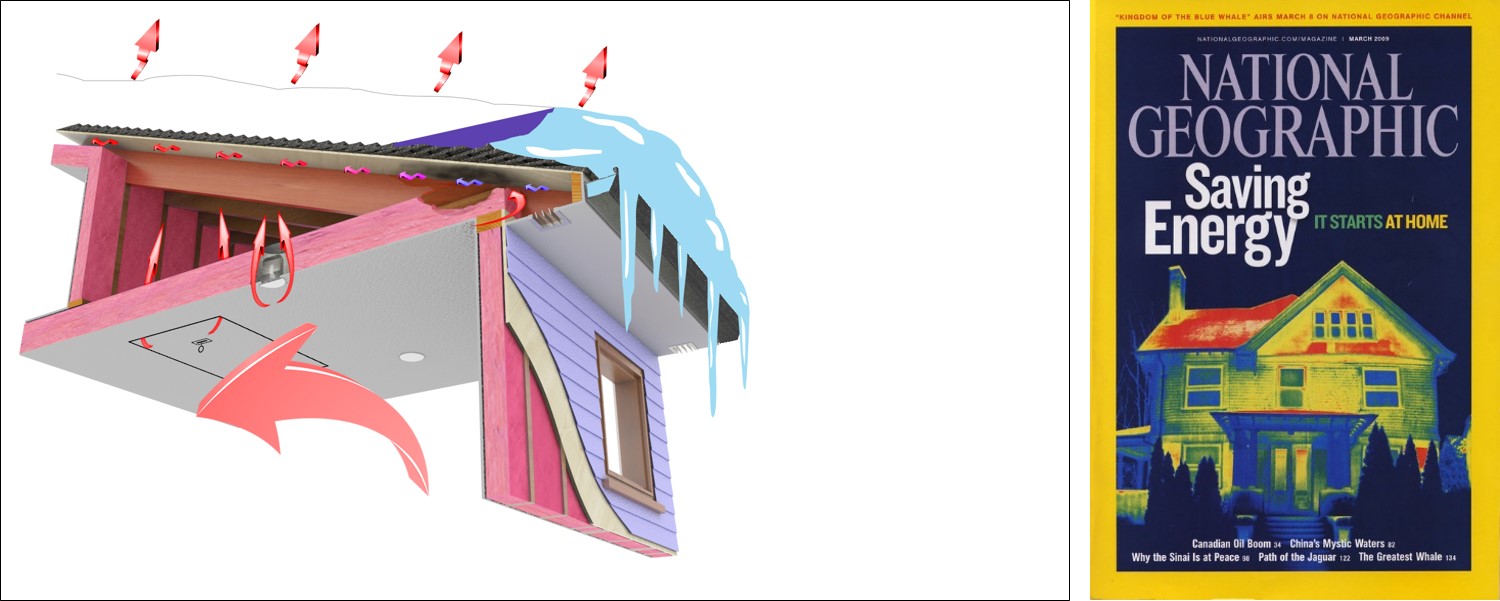

Hanging icicles and missing patches of rooftop snow tell a story in the open that more expensive digital thermography sees in the dark [3].
It's a simple fact of nature that HEAT FLOWS from a warmer place to a colder place - whether by conduction through a material, by radiation from a surface, or by a volume of convecting air. Since winter heating (and summer air conditioning) is expensive, our buildings try to resist these heat flows: INSULATION traps dry air pockets that greatly reduce conduction, reflective surfaces and LOW-e coatings interrupt radiation gains and losses, and building wraps, WEATHER STRIPPING and sealants block the unwanted convection of cold winter drafts and humid summer air alike. And yet, so many homes bleed heat - WHY?
BAD NEW$ Part I: Unfortunately, all of these protective heat flow barriers are susceptible to INTERRUPTION or DAMAGE. First, there are various "built in" interruptions - like 2x framing studs which conduct heat through walls and ceilings, or windows which offer only a fraction of their wall’s thermal protection. Second, there are barriers which just wear down or get damaged over time, like broken weather seals which lead to drafty windows and doors, although these at least make themselves known. Third, and perhaps worst of all, are interruptions that lead to other damages and further produce A VICIOUS CYCLE OF INCREASING HEAT LOSSES. In this regard, of particular concern are various roof and/or attic penetrations such as around chimneys, vent pipes, skylights, ductwork, access panels and recessed ceiling lights, because their heat losses tend to be out of sight and thus out of mind. As heat escapes through ceiling framing or recessed lighting and melts rooftop snow, the water ponds and ice dams freeze, damaging roof construction AND insulation and thus allowing even more heat to escape. Fortunately, ICICLES are among the BEST EVIDENCE that this vicious heat loss cycle is in action.
BAD NEW$ Part II: But if that weren't bad enough, heat losses are just the tip of the iceberg. FALLING chunks of icicles damage parked cars, crush plantings, and can be dangerous or even deadly to passers-by. FREEZE and THAW cycles damage shingles, sheathing and rafters, and saturate insulation, rendering it useless. The faster your home loses heat, the harder your FURNACE or boiler works to replace that heat, shortening its equipment lifespan. And the more these heating appliances are on the job, the more CO2 they release into the atmosphere. So FIXING the thermal protection gaps in the homes we heat - beyond our own COMFORT and BOTTOM LINE - is connected to a whole host of SAFETY, REAL ESTATE VALUE and ENVIRONMENTAL concerns.
3 See, Miller, Peter. "Saving energy: it starts at home." National Geographic 215, no. 3 (2009): 60-81. See article here.